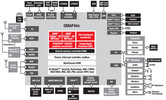Test Samsung Galaxy Tab 2 10.1 Tablet/MID
Texas Instruments OMAP 4430 | PowerVR SGX540 | 10.10" | 585 g

Der Texas Instruments (TI) OMAP 4430 ist ein SoC (System on a Chip) für Handys und Tablet PCs. Er beinhaltet zwei ARM Cortex-A9 (ARM v7 Instruction Set) Rechenkernen mit 1-1.2 GHz und ARMs SIMD Engine NEON. Zusätzlich sind zwei Cortex M3 Kerne für Multimediafunktionen integriert. Die integrierte PowerVR SGX540 Grafikkarte wird mit 304 MHz getaktet und kann wie die zwei Prozessorkerne auf den Dual Channel LPDDR2 Speicherkontroller (max 400MHz) zugreifen.
Die Performance der Rechenkerne liegt auf dem Niveau eines Nvidia Tegra 2 SoCs. Bei der Flash Performance im GUIMark 2 und Linpack Benchmarks unter Android liegen sie in etwas auf einem Level. Im Architektruvergleich fehlt dem Tegra 2 jedoch die SIMD Engine und auch das Speicher Interface ist nur als Single Channel ausgelegt.
Die Grafikperformance ist oft vergleichbar, wobei es Einzeltests gibt (RightWare Basemark ES 2.0) wo sich der SGX 540 deutlich durchsetzen kann.
Der Stromverbrauch ist mit angegebenen 100uW - 600mW relativ gering und eignet sich daher auch für den Einsatz in Smartphones.
| Serie | |||||||||||||||||||||||||
| Codename | Cortex A9 | ||||||||||||||||||||||||
Serie: Cortex A9
| |||||||||||||||||||||||||
| Taktung | 1000 MHz | ||||||||||||||||||||||||
| Level 1 Cache | 1 MB | ||||||||||||||||||||||||
| Anzahl von Kernen / Threads | 2 / 2 | ||||||||||||||||||||||||
| Stromverbrauch (TDP = Thermal Design Power) | 0.6 Watt | ||||||||||||||||||||||||
| Herstellungstechnologie | 45 nm | ||||||||||||||||||||||||
| Features | Dual Channel LPDDR 400MHz Memory Controller, IVA 3 Multimedia Accelerator, PowerVR SGX 540 Graphics Core, Image Signal Processor | ||||||||||||||||||||||||
| Architecture | ARM | ||||||||||||||||||||||||
| Vorgestellt am | 01.03.2011 | ||||||||||||||||||||||||
| Produktinformationen beim Hersteller | www.ti.com | ||||||||||||||||||||||||
BlackBerry Playbook WiFi 16GB: PowerVR SGX540, 7.00", 0.4 kg
Test » Test BlackBerry Playbook WiFi 16GB Tablet/MID
Toshiba Excite 10 LE: unknown, 10.10", 0.5 kg
Externer Test » Toshiba Excite 10 LE
Samsung Galaxy Tab 2 10.1: PowerVR SGX540, 10.10", 0.6 kg
Externer Test » Samsung Galaxy Tab 2 (10.1")
Amazon Kindle Fire 7": PowerVR SGX540, 7.00", 0.4 kg
Externer Test » Amazon Kindle Fire 7"
Toshiba AT200: PowerVR SGX540, 10.10", 0.5 kg
Externer Test » Toshiba AT200
» Vergleich mobiler Prozessoren
Alle CPU Serien für Notebooks mit kurzer Beschreibung
» Mobile Prozessoren - Benchmarkliste
Sortier- und filterbare Benchmark-Liste